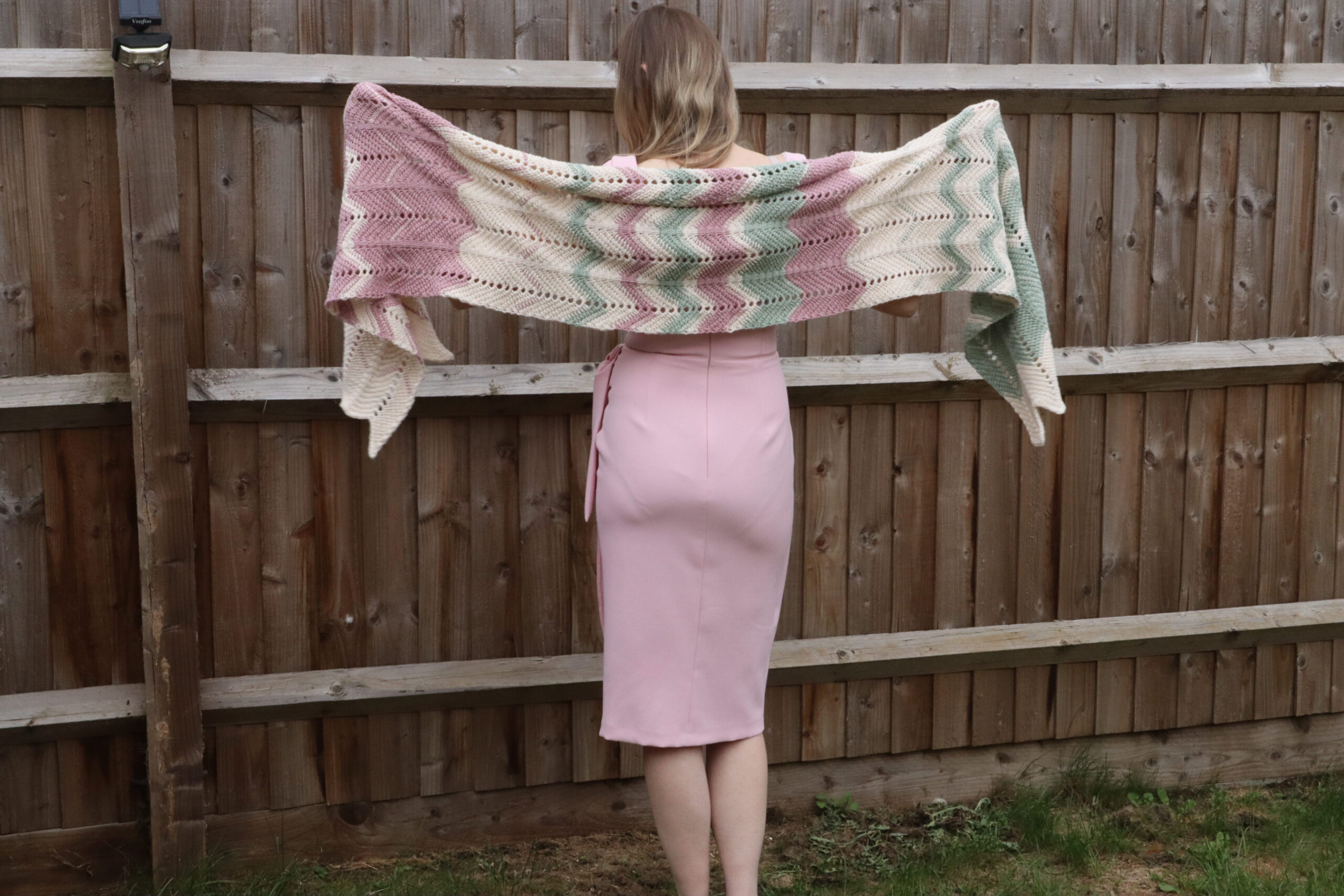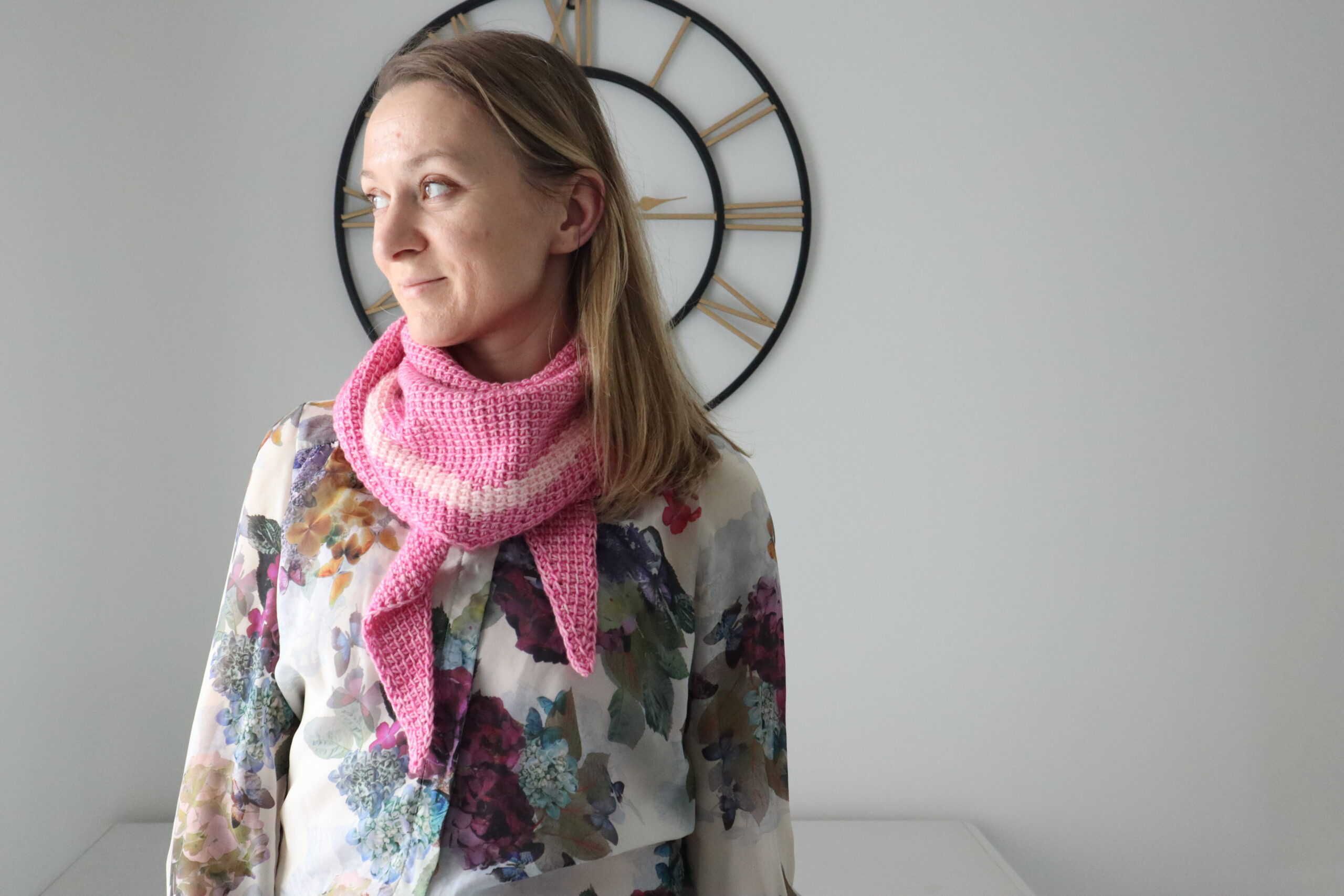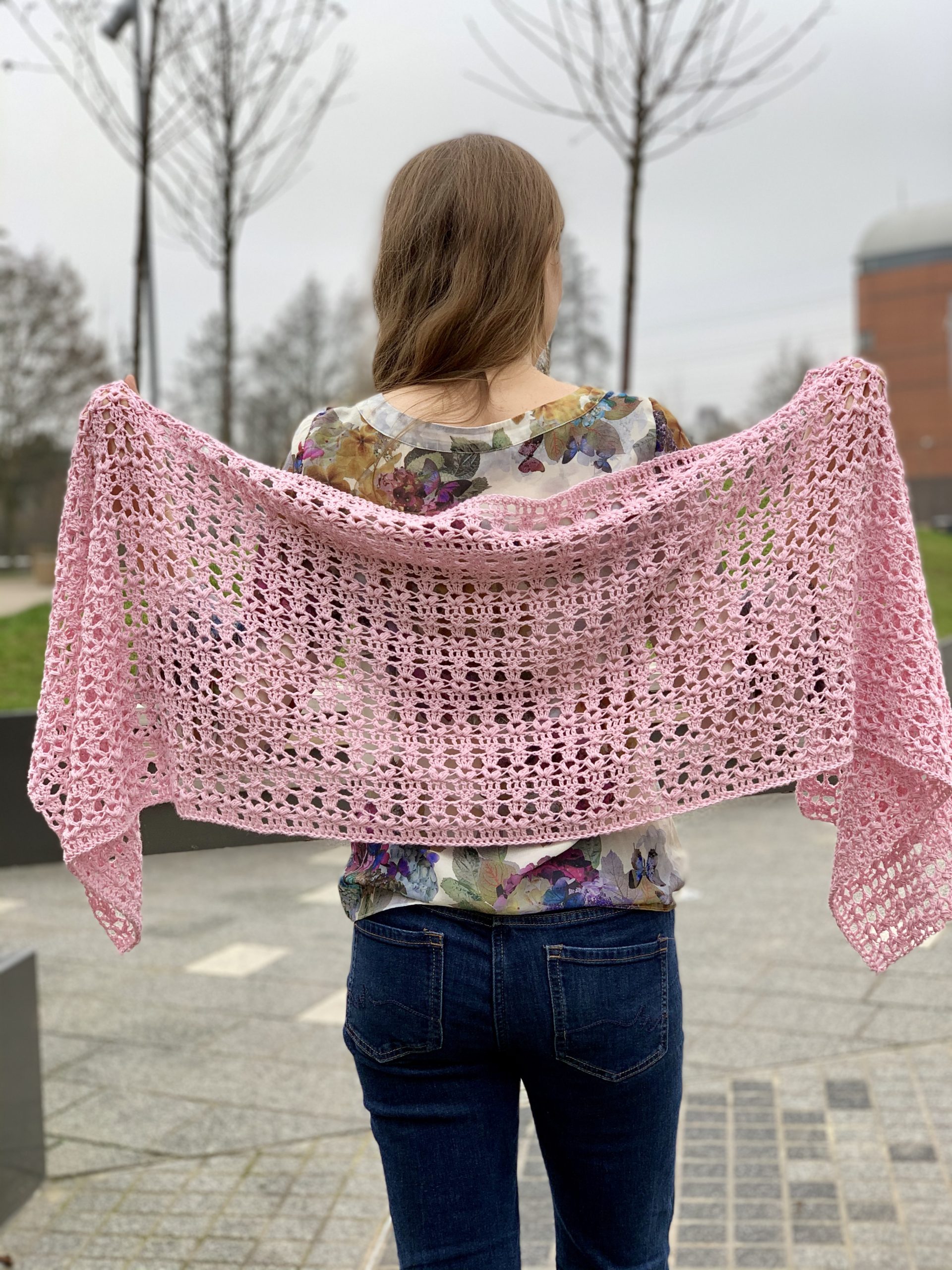Leora Shawl is a chevron Tunisian crochet shawl with elements of lace and colourwork. The light weight yarn makes it a perfect accessory for transitional weather between seasons.
The pattern is perfect for beginners and intermediate crocheters who enjoy a fusion of simple stitch pattern and colourwork that elevates the finished product to a wonderful piece perfect for gifting.
Last updated: 22/04/2024
You can purchase the add free PDF version of the pattern at LoveCrafts here and Ravelry here.
This site contains affiliate links to products. We may receive a commission for purchases made through these links at no extra cost to you. This helps to cover the running cost of the website and enables me to continue making free patterns.
Please NOTE that this pattern is subject to copyright and is my intellectual property. The online version is for personal use only. Do not re-publish or sell this pattern in part or full or make video tutorials of it. Any such actions are a breach of copyright and can result in legal action.

Skills required:
To create this beautiful chevron crochet shawl you will need to master (or already know) these stitches and techniques:
Chain, Tunisian crochet technique (alternating forward and return passes), Tunisian simple stitch (tss), simple colourwork in Tunisian crochet- stripes, stitch pattern bind-off, blocking.
Skill level:

Finished measurements:
The final chevron crochet shawl measurements (blocked):
203 x 41 cm (approx. 80 in x 16 in)
Materials and tools
To get the exact look as on the pictures of my chevron crochet shawl, you will need:
Hobbii Friends Cotton Silk (78% Cotton, 22% Silk | DK weight yarn | 50 g (1.75 oz) = 120 m (131 yds), Oatmilk (#03) 4 balls (A), Antique Rose (#53) 2 balls (B), Misty Green (#113) 2 balls (C)

Tunisian crochet hook size 5 mm (US size H-8) with cable (at least 100 cm (15”)) or size to obtain the gauge
Tapestry needle
Scissors
Other yarn alternatives:
Please always swatch when substituting yarn:
Cewec Papyrus
Rico Design Luxury Organic Cotton Silk DK
Ice Yarns Silk Cotton
Hobbii Friends Cotton Silk | Substitutes (yarnsub.com)
You can get your craft supplies here.

Gauge:
Blocked Gauge:
17 sts x 12 rows = 10 x 10 cm (4 x 4 in) over st pattern measured diagonally
Gauge helps you to understand how the project turns out in terms of the final size. If you would like to achieve the exact size of the final project as in the instructions above, you gauge needs to match exactly to the above.
If you get more stitches and/or rows than stated above using the exact hook size as per instructions, your final project will turn out smaller. Conversely, if you get less stitches and/or rows than stated above using the exact hooks size as per instructions, your final project will turn out bigger.
To make adjustments, if you get more stitches and/or rows, you can try using bigger hook size to get closer to the desired size. Conversely, if you get less stitches and/or rows, you can try using smaller hook size to get closer to the desired size.
It may take trial and error to try out a few hook sizes to achieve the exact size.
Alternatively, if you really don’t want to make several samples to achieve the desired size, you can try to alter your tension as you work the project. However, I would advise to try this out once you master the basics of Tunisian crochet as it may be a bit tiresome to try to master the basics of Tunisian crochet and focus on alternating your tension while working the project.
If this chevron crochet shawl is your first Tunisian crochet project and are not sure if this project matches your skills, I have a Tunisian crochet masterclass tutorial that will jump-start your Tunisian crochet journey!
Stitch guide:
Tunisian crochet stitches are worked in 2 steps; forward and return pass from right to left, with the number of sts (lps) increasing on the hook during the forward pass and decreasing during the return pass.
Return pass is worked in the same way for all stitches (rows of sts) used in this project as follows: 1 ch, *yrh, draw through 2 lps on hook, rep from * until 1 lp on hook.
Edge stitches:
Right edge stitch- This is the first lp on hook and counts as first st unless otherwise stated.
Left edge stitch- This st is referred to in the pattern as the End Stitch (ES) and is crocheted as follows: Rotate the end of the fabric towards yourself, insert the hook under both bars (left and right) of the last st, yrh and pul.
Tunisian crochet stitches:
- First row of Tunisian crochet: Insert the hook in the back bump of second ch from hook, yrh and pul across.
- Tunisian simple stitch: Insert the hook from right to left under front vertical bar, yrh and pul. Standard return pass.
Bind off:
Stitch pattern bind off: Follow the stitch pattern as established in Row 3, but instead of keeping lps on the hook, pull each lp through lp that is already on the hook. This will result in 1 lp travelling on the hook through the row. Continue across the row including ES, cut the yarn and fasten-off.

| Abbreviations: | |
| ch- chain | yrh- yarn round the hook |
| st(s)- stitch(es) | pul- pull up a loop |
| lp(s)- loop(s) | FP- forward pass |
| tss- Tunisian simple stitch | RP- return pass |
| approx.- approximately | RS- right side |
| rep- repeat |
Stitch chart:
Notes:
- The chevron crochet shawl is worked flat, RS facing from right to left and bottom up.
- The stitch count refers to the number of lps on hook on FP.
- Bind off row should be worked loosely to allow for the extra stretching during blocking.
- Blocking the shawl is recommended for this project as it opens up lace stitches and highlights the stitch pattern.
- The basic stitch pattern is worked over 20 + 2 sts.
Instructions:
Shawl
With A, chain 82.
First segment, alternating A and B
Row 1 FP: Insert the hook in the back bump of second ch from hook, yrh and pul across. 82 lps on hook.
Row 1 RP: Yrh, pull through 3 lps, * [yrh, pull through 2 lps] 8 times, ch 1, [yrh, pull through 2 lps] 8 times, yrh, pull through 5 lps; rep from * to end with last yrh, pull through 4 lps.
Row 2: Ch 1, skip first cluster * tss in next 8 sts, [insert hook from front to back through ch-1 sp, pul, ch 1] 4 times, tss in next 8 sts, work tss in 4 sts of next cluster; rep from * to last cluster, insert hook under all front vertical bars of last cluster except for ES, yrh and pul, ES.
Row 2 RP: Yrh, pull through 4 lps, * [yrh, pull through 2 lps] 8 times, ch 1, [yrh, pull through 2 lps] 8 times, yrh, pull through 9 lps; rep from * to end with last yrh, pull through 4 lps.
Row 3: Ch 1, skip first cluster * tss in next 8 sts, [insert hook from front to back through ch-1 sp, pul, ch 1] 4 times, tss in next 8 sts, work tss in middle 4 sts of next cluster; rep from * to last cluster, insert hook under all front vertical bars of last cluster except for ES, yrh and pul, ES.
Row 3 RP: Rep Row 2 RP.
Rows 4-8: Rep Row 3.
Row 9 FP: Rep Row 3.
Row 9 RP: with B, yrh, pull through 4 lps, * [yrh, pull through 2 lps] 8 times, ch 1, [yrh, pull through 2 lps] 8 times, yrh, pull through 9 lps; rep from * to end with last yrh, pull through 4 lps with A.
Row 10-14: with A, Rep Row 3.
Row 15 FP: Rep Row 3.
Row 15 RP: with B, yrh, pull through 4 lps, * [yrh, pull through 2 lps] 8 times, ch 1, [yrh, pull through 2 lps] 8 times, yrh, pull through 9 lps; rep from * to end with last yrh, pull through 4 lps.
Row 16: with B, Rep Row 3.
Row 17 FP: with B, Rep Row 3.
Row 17 RP: with A, yrh, pull through 4 lps, * [yrh, pull through 2 lps] 8 times, ch 1, [yrh, pull through 2 lps] 8 times, yrh, pull through 9 lps; rep from * to end with last yrh, pull through 4 lps.
Rows 18-20: with A, Rep Row 3.
Rows 21-23: Rep Rows 15-17.
Rows 24-25: Rep Row 3.
Row 26: Rep Row 15.
Rows 27-28: with B, Rep Row 3.
Row 29: Rep Row 17.
Row 30: with A, Rep Row 3.
Row 31: Rep Row 15.
Rows 32-34: with B, Rep Row 3.
Rows 35-37: Rep Rows 29-31.
Rows 38-42: with B, Rep Row 3.
Row 43 FP: with B, Rep Row 3.
Row 43 RP: with A, yrh, pull through 4 lps, * [yrh, pull through 2 lps] 8 times, ch 1, [yrh, pull through 2 lps] 8 times, yrh, pull through 9 lps; rep from * to end with last yrh, pull through 4 lps with B.
Rows 44-51: with B, Rep Row 3.
Row 52: Rep Row 17.

Second segment, alternating A, B and C
Rows 53-60: with A, Rep Row 3.
Row 61: Rep Row 9.
Rows 62-66: with A, Rep Row 3.
Row 67 FP: Rep Row 3.
Row 67 RP: with C, yrh, pull through 4 lps, * [yrh, pull through 2 lps] 8 times, ch 1, [yrh, pull through 2 lps] 8 times, yrh, pull through 9 lps; rep from * to end with last yrh, pull through 4 lps.
Row 68: with C, Rep Row 3.
Row 69 FP: with C, Rep Row 3.
Row 69 RP: with A, yrh, pull through 4 lps, * [yrh, pull through 2 lps] 8 times, ch 1, [yrh, pull through 2 lps] 8 times, yrh, pull through 9 lps; rep from * to end with last yrh, pull through 4 lps.
Rows 70-72: with A, Rep Row 3.
Rows 73-75: Rep Rows 15-17.
Rows 76-77: with A, Rep Row 3.
Row 78: Rep Row 67.
Rows 79-80: with C, Rep Row 3.
Row 81: Rep Row 69.
Row 82: with A, Rep Row 3.
Row 83: Rep Row 15.
Rows 84-86: with B, Rep Row 3.
Row 87: Rep Row 17.
Row 88: with A, Rep Row 3.
Row 89: Rep Row 67.
Rows 90-94: with C, Rep Row 3.
Row 95 FP: with C, Rep Row 3.
Row 95 RP: with A, yrh, pull through 4 lps, * [yrh, pull through 2 lps] 8 times, ch 1, [yrh, pull through 2 lps] 8 times, yrh, pull through 9 lps; rep from * to end with last yrh, pull through 4 lps with B.
Rows 96-103: with B, Rep Row 3.
Row 104: Rep Row 17.

Third segment, alternating A and C
Rows 105-112: with A, Rep Row 3.
Row 113 FP: Rep Row 3.
Row 113 RP: with C, yrh, pull through 4 lps, * [yrh, pull through 2 lps] 8 times, ch 1, [yrh, pull through 2 lps] 8 times, yrh, pull through 9 lps; rep from * to end with last yrh, pull through 4 lps.
Rows 114-118: with A, Rep Row 3.
Row 119: Rep Row 113.
Row 120: with C, Rep Row 3.
Row 121 FP: Rep Row 3.
Row 121 RP: with A, yrh, pull through 4 lps, * [yrh, pull through 2 lps] 8 times, ch 1, [yrh, pull through 2 lps] 8 times, yrh, pull through 9 lps; rep from * to end with last yrh, pull through 4 lps.
Rows 122-124: with A, Rep Row 3.
Rows 125-127: Rep Rows 119-121.
Rows 128-129: with A, Rep Row 3.
Row 130: Rep Row 113.
Rows 131-132: with C, Rep Row 3.
Row 133: Rep Row 121.
Row 134: with A, Rep Row 3.
Row 135: Rep Row 113.
Rows 136-138: with C, Rep Row 3.
Rows 139-141: Rep Rows 133-135.
Rows 142-146: with C, Rep Row 3.
Row 147 FP: with C, Rep Row 3.
Row 147 RP: with A, yrh, pull through 4 lps, * [yrh, pull through 2 lps] 8 times, ch 1, [yrh, pull through 2 lps] 8 times, yrh, pull through 9 lps; rep from * to end with last yrh, pull through 4 lps in C.
Rows 148-155: with C, Rep Row 3.
Row 156: Rep Row 121.
Rows 157-164: with A, Rep Row 3.
Row 165: Stitch pattern bind-off.
Fasten-off.

Finishing:
Weave in all ends and block the chevron crochet shawl to final measurements as above.
I would love to see and share your work on social media, use #leorashawl or #exquisitecrochetuk.
Pattern support: exquisite.crochet.uk@gmail.com
Further resources:
Pattern video tutorial:
Basic Stitch pattern:
Colour changes:
For endless crochet inspiration, you can subscribe to AllFreeCrochet website here.
If you prefer to have all your craft inspiration in one place, FaveCrafts is definitely the place to go. Why not subscribe to their newsletter here so you would not miss a thing!
You can purchase the add free PDF version of the pattern at LoveCrafts here and Ravelry here.
Did you enjoy the Leora Shawl pattern? Why not try my other crochet shawl patterns:





Thank you so much if you got this far in the pattern! I hope you got inspired for your own version using various colours. I can’t wait to see it! Don’t forget to tag me on Instagram and let me know in the comment section below how you got on with it! As always, if you have any pattern query, the quickest way to get it answered is by emailing me on the pattern support email address above.
Happy crocheting!




